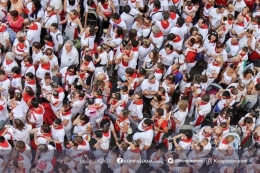Byzantium, Constantinople and Istanbul, these names are addressed to the same place which now we call it as Istanbul. According to the latest excavation during the building of the Marmaray Tunnel in 2008, the history of Istanbul has begun from 6700 BC, that’s where they found numerous the remains of sinking ships belong to the earliest human settlement of the metropolis. In 700 BC, when the Greek Colonists led by King Byzas arrived in the city, they nailed down there because of the strategic location along the Bosphorus Strait, and late King Byzas named the city as Byzantium.
Succeeding its progression by the Greeks, Byzantium became an important part of the Roman Empire in the 300s, Inevitably makes the Roman Emperor Constantine the Great attempted the construction project to reconstruct the entire city. His aspiration was to create and fill the city of Byzantium with monuments, grand buildings and palaces as same as exists in Rome, which was recognized with its extraordinary luxurious buildings at that time. Eventually, in 330s the Great Constantine declared the city of Byzantium as the Capital city of the entire Eastern Roman Empire and renamed it Constantinople.
The History of Palaces in Constantinople begins with the Great Palace in the year of 330, it was built by the Emperor Constantine I following the annunciation of the Capital City of the Eastern Roman Empire. Furthermore, the palace is located in the region of the Blue Mosque and Hagia Sophia according to nowadays’ condition. The utilization of the palace was as Imperial Administration and has been engaged for over 800 years, unfortunately only a few remnants and shards of the palace have survived until today.
Another important palace is the Palace of Blakhernai, in spite of not being the biggest palace in the city, Blakhernai Palace was preferred and thus transformed into the official palace because of the location was near to the hunting grounds (which was one of the most popular entertainment of that time) also it was safer than the Great Palace. Additionally, Blakhernai Palace, located beside the Golden Horn in the western north of Constantinople as well as being adjacent to the city walls. Therefore, it is more protected than the Great Palace. During the First Crusade the Emperor of Byzantine between 1081 - 1118 Alexios I Komnenos received the commanders in this palace and he also added many buildings and expand the castle in order to fit the amount of the invitee.
Blakhernai Palace divided into a few parts; church, prison and palace itself, and one of them is the Anemas Dungeons. Anemas Dungeons are a prison. On the other hand, this is not an ordinary prison, merely it is a sort of high ranking state prison in the metropolis. The name of Anemas is taken from the first person to be imprisoned there, he was a Byzantine general who rose against Emperor Alexios I Komnenos. In the Byzantine period and after the Latin occupation Anemas Prison was used as a prison, but there is no information how it was used after the Ottoman conquest in 1453. The other one is Tekfur Palace, Tekfur Palace is the sole part of Blakhernai Palace which still survive today (not including the prison). The name of Tekfur derived from Arabic, the term tekfur was used in the early Ottoman period for the Byzantine Emperors and feudal lords.
The last palace will be mentioned is; Palace of Hebdomon, located in Bakırköy. Which was the most important settlement outside the City of Constantinople. Hebdomon is Byzantines, which means ‘’seventh’’, and in Latin it was called Septimum which also means ‘’seventh’’. The factor why they put the name is because the location of the Hebdomon Palace is in the seventh mile leading the way to Rome from Milion column, which was recognized for being the starting point of all imperial routes. According to Asuman Denker and the other writers in their book Byzantine Palace in Istanbul ‘’In the beginning Hebdomon was a simple fishing village, but it later gained in importance with the development of the Byzantine Empire and became a popular resort for the nobility’’. Hebdomon Palace is not a single place, it has two other different palaces the first one is Magnura or Eudomon Palace and the other one is Jukundianae or Secundianae Palace.
The Palace of Magnura or Eudomon Palace, has no certain data about who was arranged to built up the palace, ‘’either by Emperor Constantine I or by his son Constantine II’’ (2011). Moreover, the design of the palace was to accommodate ambassadors and other important customers and guests visiting the town as well as for being used as a summertime home.
The Palace of Jukundianae or Secundianae is the second palace complex situated in Hebdomon. Unlike the Magnura Palace the founder of Jukundianae Palace is recognizable, he is Theodosius II. It said that it is more accurate to call it Jukundianae than Secundianae, as it means ‘’entertainment’’ or ‘’pleasure’’. Unfortunately, in the 6th century as a result of an earthquake, it was demolished, following the demolition, the Emperor Justinian beside restoring the palace, also built some churches, public baths and other public buildings in the vicinity of the palace (2011). And today, owing to the fact that it's impossible to see the original location of the palace, a few architrave blocks, the columns and the column capitals belong to the palace are available for public at the Istanbul Archeological Museum.
Bibliography:
1.Denker, Asuman, Gülbahar Baran Çelik, and Gülcan Kongaz. İstanbul’daki Bizans Saraylar Byzantine Palaces in Istanbul. Istanbul: Istanbul Arkeoloji Müzeleri, 2011. Print.
2.http://geography.about.com/od/specificplacesofinterest/a/istanbul.htm Web. 21/May.2014.
3.http://placesinistanbul.com/in-info-istanbul-the-prison-of-anemas.htm?placeID=129&lan=EN Web. 21/May/2014.
Baca konten-konten menarik Kompasiana langsung dari smartphone kamu. Follow channel WhatsApp Kompasiana sekarang di sini: https://whatsapp.com/channel/0029VaYjYaL4Spk7WflFYJ2H








